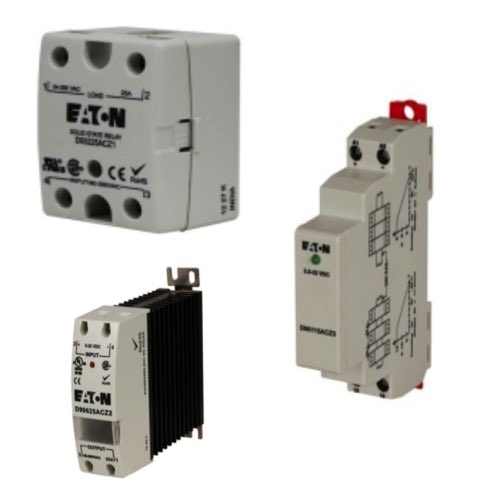Eaton Solid State Relays

Eaton single pole, single throw (SPST) solid state relays provide reliable electronic switching for industrial and commercial control applications. Designed to switch electrical loads without mechanical contacts, these relays deliver fast response times, precise control, and consistent performance in systems where accurate voltage and current control are required.
One of the primary advantages of Eaton solid state relays is their ability to switch rapidly with minimal electrical noise. This makes them well suited for automation, process control, heating, and power management applications where signal integrity and system stability are critical. Because SSRs do not rely on physical movement, they operate silently and reduce electromagnetic interference compared to electromechanical relays.
Eaton SPST solid state relays are engineered for long service life and dependable operation in harsh environments. With no moving parts, they resist mechanical wear and are less susceptible to failure over time. Built-in features such as thermal management and surge protection help safeguard against overheating and electrical transients. Eaton SSRs are tested and certified to meet recognized safety and performance standards, including UL, CSA, and CE requirements.
FAQs
Q: What is a single pole, single throw solid state relay?
A single pole, single throw solid state relay is a switching device that controls one circuit in either an on or off state using solid-state electronics rather than mechanical contacts.
Q: How do solid state relays differ from electromechanical relays?
Solid state relays use semiconductor and optical components to switch loads, while electromechanical relays rely on moving contacts and an electromagnet. SSRs offer faster switching, silent operation, and longer service life.
Q: What are the benefits of using Eaton solid state relays?
Eaton SSRs provide precise control, reduced electrical noise, high durability, and reliable performance in demanding industrial environments.
Q: Are Eaton solid state relays suitable for harsh environments?
Yes, Eaton solid state relays are designed to withstand extreme temperatures, humidity, and electrical stress, with protective features to guard against surges and overheating.
Q: What certifications do Eaton solid state relays carry?
Eaton solid state relays are tested and certified to meet major industry standards, including UL, CSA, and CE, ensuring safety and compliance.
Why Buy Eaton Solid State Relays from RSP Supply
RSP Supply offers a complete selection of Eaton single pole, single throw solid state relays to support a wide range of control and automation applications. Our product offerings are suited for industrial environments where reliability, accuracy, and compliance are essential. Customers rely on RSP Supply for knowledgeable support, dependable sourcing, and high-quality components for long-term system performance.

